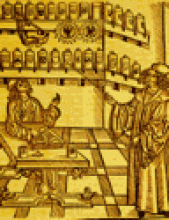“An elderly woman, born in 1904, so 98 years old,” says the intern, beginning his morning report. “She lives with her husband; her daughter and son-in-law are next door and they're in their seventies. She fell and suffered a nondisplaced acetabular fracture of the right hip. Ortho has seen her and cleared her hip for weight-bearing. She was too frail to go home and was in pain, so she was referred to medicine, no surprise. Review of systems was not helpful. No syncope before the fall. No other active medical problems. She helps care for her husband, who is also quite frail and in his late 90s. She doesn't want to get up and ambulate. She says she wants to get better, but that it hurts to get up so she won't. We tried morphine but it confused her, and Tylenol doesn't seem to be working very well.”

Figure. Photo by: Fred Sebastian
I question the resident. “She won't recover if she doesn't get out of bed. Have you told her as much?”
“Yes. She says she wants to get better, but she doesn't want to get up. I can't seem to convince her.”
I agree to have a talk with her. I stand with the white-coated residents in a half-circle around her bed and we discuss her hip, the importance of moving, of getting out of bed. I explain that at her age she can't afford to be immobile. Lying in bed could even be fatal, I explain. She nods in response, gazes directly into my eyes. Clearly, she understands. She agrees she should get up, but it hurts too much. She can't. She won't.
Impasse. I know the disease but not the person. To survive to 98 in good health can take courage and determination. I ask about her world and her life.
“You must have seen a lot in your time.”
“Some good times and some bad, yes.”
“What were some of the good things?”
She talks a little about her marriage, and her job. Then she pauses, as if a thought has distracted her.
“The year my father died, I was 12. I was the oldest of five and had to go to work. I walked miles to the factory every day. And then I had to help with my brothers and sisters when I got home. We were poor, we had nothing.”
“It must have been hard.”
“It was hard. But the hardest time was years later. When my son died.”
“What happened?” I ask.
She looks away from me to a point above her bed. I sense tension in the bodies of the interns and medical students beside me as she begins to speak.
“I was working in the kitchen. I heard Carl yell. He said Don't go, Georgie!”
In her telling she softly yells a warning to a five-year-old boy who died almost three-quarters of a century before, a warning that was not heeded. Carl, her other son, was nine. He saw the truck; Georgie did not. Georgie ran out into the road where he was struck and killed.
I pictured a black panel truck with bulbous headlights mounted on curving fenders. I resisted the picture of what she would have seen; a small child lying broken and bleeding.
“I told them to keep away from the road. But you know how children are.”
The next day, her pain is better and she is up walking. A week later, she goes home.
A memory of her lingers, leaving me searching for stories. In my clinic a month or so later I meet a woman with a large number of complaints that I cannot ascribe to any particular illness. Her congenital kyphoscoliosis, a lifelong affliction, requires her to make repeated and deliberate efforts to look upward in order to meet my eye. Much of the history she volunteers consists of commentaries about the quality of care previous physicians have provided, none terribly flattering. I worry that my name will be added to this list of failed clinicians and so I vigorously try to extract a history that will allow me to pigeonhole her illness. Like a dumb tourist, when I cannot keep her on track I try speaking more loudly.
“You don't need to raise your voice” she admonishes me. I feel shamed and, looking for a break, I change direction. I try for a social history, letting go of the clinical facts that I can't work out. Occupation, interests, safer topics. I ask about work and family. We make small talk for a minute or two. She cranes her neck upward and to the side, looking me in the eye as she answers each of my questions.
“Married?” I ask.
She does not look up this time. “No. No one would have me,” she says, quietly but firmly. I wait for her to return my gaze.
I wait for her to tell her story.
Stephen Workman Assistant Professor Department of Medicine Dalhousie University Halifax, NS








